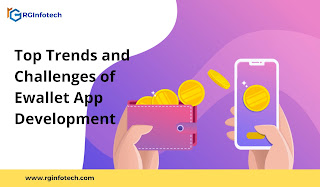Top Trends and Challenges of Ewallet App Development
In the past few years, the cashless industry has seen enormous growth. From Payment Gateways to e-wallets, soon there will be no credit/debit cards and virtual currencies in the contactless industry. Businesses and consumers both found e-wallet apps to be really helpful.
Global e-wallet growth
With the change in the digital economy, there is a shift in customer behavior towards e-wallet and contactless payments.
E-waller global market will grow by $2.1 trillion by the end of the year 2023, with a CAGR rate of 15%.
According to Near Field Communication, there was a 20% growth in contactless payment due to simplicity and by the year 2026, it will grow more.
The mobile wallet market will be worth $7580.1 trillion by the year 2027 with a rate of 28.2% CAGR.
Types of eWallets
There are numerous types of wallets like e-wallet, closed wallets, etc.
Closed eWallets
Closed e-wallets are integrated with the respective payment gateways only.
A closed eWallet app is tightly integrated with the payment gateway of the issuer. The user can initiate payments to the issuer. Airlines, hotel chains, big stores like Walmart and Nykaa, and online stores like Flipkart and Makemytrip, have their closed eWallets. These instruments do not allow cash withdrawals or redemption.
Semi-Closed eWallet
Semi-closed wallets are best to use as they can be used for both online and offline purchases. One can not do cash withdrawal or redemption. Users can install these wallets and make payments on multiple payments. Amazon, Apple Pay, Samsung Pay, etc. are considered semi-closed e-wallet.
Open eWallets
Open e-wallets are used to make payments anywhere from any platform like grocery purchases, financial investments, transactions of funds, and withdrawal of cash from ATM/bank. M-Pesa of Vodafone is the open online wallet launched by numerous countries.
Challenges in e-Wallet App Development
Developing an e-wallet is not like applying butter on bread, there are many challenges like technical, budget, integration with other platforms, etc. that come along the way while developing the e-wallet.
Technological Challenges
Developing a secure, fast, and simple e-wallet is a challenge in itself. It is not easy to align all these three features on one platform.
Guidelines Compliance
There are certain guidelines issued by central banks to regulate the finance and money on e-wallet applications. If one platform doesn’t know the rules or how to comply with them, they won’t be able to successfully operate that e-wallet application. Hire experienced companies like RG Infotech to build such applications for you. The rules might vary based on geographical location, bank rules, etc.
Fraud Detection
E-wallet is still a new service for people. People who are not aware of it can become the victim of online fraud and that’s the reason many users avoid the use of e-wallet for payment/purchase. Make sure, your e-wallet is EU-GDPR compliant; so users can trust their services.
Customer Mindset
People are still not acquainted with the e-wallet and changing their mindset will be a challenge for the e-wallet operating platforms. Customers are still using cash, credit cards, debit cards, and checks to operate their business. E-wallet platforms can only change their minds by including features like simplicity, proposition, security, ease of use, and other benefits.
Trust issues
In a YouGov research it was found that more than 40% of the smartphone users have trust issues with eWallets, and a similar number of people are afraid that if their phone gets lost, they will lose all their money. If you do not trust a financial instrument, you will never keep your money in it. People also have concerns related to privacy and confidentiality.
Future Trends of E-wallet App
Digital Wallets have become a common payment method. Digital currency like Cryptocurrency, NFC, and smart technology of Artificial Intelligence is making some serious changes in the fintech space and e-wallet is also getting benefits from the changes.
Biometric Verification
Security is the primary concern when our phone is with someone else, biometric authentication can provide safety. Biometric authentication uses individual identifiers like fingerprints, faceprints, rental scans, or voice recognition.
Biometric authentication is not only used for e-wallet; it is widely accepted in security systems, banks, etc. It saves from online fraud and increases the credibility of services.
Smart Speakers
Smart speakers or home assistants have already become a part of daily lives. They work on voice commands of particular users like the smart speakers of Amazon, Google, and Apple; who also control smart homes.
This technology lets you make online purchases, bill payments, order food, etc. without using phone screens. It's a helpful innovation for all those who are not well versed with technology and find it difficult to make online payments.
QR Codes
QR Codes are useful when a person doesn’t want to share his e-wallet app registered phone number. It makes online transactions more convenient. One can send and receive the money through QR codes.
NFC Payments
NFC readers and chips have made contactless payments - a matter of a few seconds. Ewallets of Samsung, Google, and Apple already have NFC payment features.
Over time countries like the UK and China have noticed an increase in NCF Payment modes in restaurants, parking lots, transports, and payphones.
Artificial Intelligence/Machine Learning
AI and ML are empowering all online e-commerce and fintech. Artificial Intelligence, allows the system to make regular payments like bills, groceries, transport, cable, etc.
AI can be used smartly to track and analyze expenditure. AI bots are smart enough to resolve pre-defined queries and save huge money.
Cryptocurrency
One of the most sophisticated digital currencies, which makes the e-wallets with cryptocurrencies on rising. Currently, there are over 40 million cryptocurrencies based on active e-wallets. These wallets are the direct source to start investing in cryptocurrencies.
Cryptocurrency users are among the most sophisticated fintech users. That is one reason why eWallets with cryptocurrencies are on the rise – there are over 40 million active cryptocurrency eWallets. They provide a direct and convenient way to start investing and trading in cryptocurrencies.
Conclusion
As the contactless payment mode is growing with time, e-wallet has made their position in the market. Developers are trying to integrate e-wallet with all types of devices, operating systems, and payment gateways to ease their use among users. You can hire web and app development services from RG Infotech, to get an e-wallet on your online platform to ease the payment process.




Comments
Post a Comment